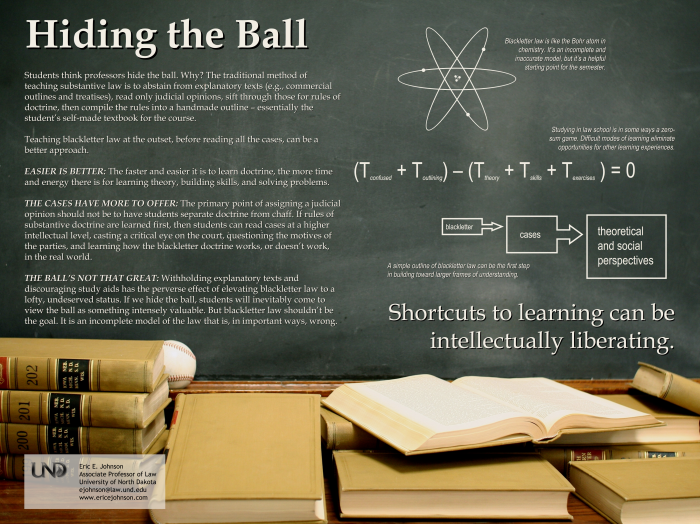Hiding the Ball poster
presented at AALS Annual Meeting, San Francisco, January 2011
Text, graphic design, and photograph by Eric E. Johnson
The text of the poster:
Students think professors hide the ball. Why? The traditional method of teaching substantive law is to abstain from explanatory texts (e.g., commercial outlines and treatises), read only judicial opinions, sift through those for rules of doctrine, then compile the rules into a handmade outline – essentially the student’s self-made textbook for the course.
Teaching blackletter law at the outset, before reading all the cases, can be a better approach.
EASIER IS BETTER: The faster and easier it is to learn doctrine, the more time and energy there is for learning theory, building skills, and solving problems.
THE CASES HAVE MORE TO OFFER: The primary point of assigning a judicial opinion should not be to have students separate doctrine from chaff. If rules of substantive doctrine are learned first, then students can read cases at a higher intellectual level, casting a critical eye on the court, questioning the motives of the parties, and learning how the blackletter doctrine works, or doesn’t work, in the real world.
THE BALL’S NOT THAT GREAT: Withholding explanatory texts and discouraging study aids has the perverse effect of elevating blackletter law to a lofty, undeserved status. If we hide the ball, students will inevitably come to view the ball as something intensely valuable. But blackletter law shouldn’t be the goal. It is an incomplete model of the law that is, in important ways, wrong.
Blackletter law is like the Bohr atom in chemistry. It’s an incomplete and inaccurate model, but it’s a helpful starting point for the semester.
(Tconfused + Toutlining) – (Ttheory + Tskills + Texercises ) = 0
Studying in law school is in some ways a zero-sum game. Difficult modes of learning eliminate opportunities for other learning experiences.
blackletter ⇒ cases ⇒ theoretical and social perspectives
A simple outline of blackletter law can be the first step in building toward larger frames of understanding.
Shortcuts to learning can be intellectually liberating.
Eric E. Johnson
Associate Professor of Law
University of North Dakota
ejohnson@law.und.edu
www.ericejohnson.com
Copyright 2011 Eric E. Johnson. All rights reserved. Konomark: Most rights sharable.


